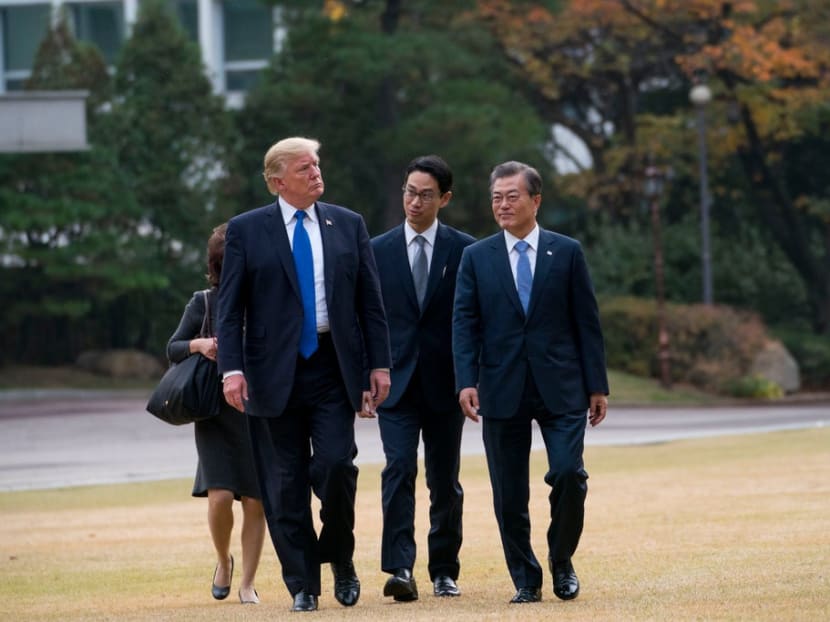Pause in military drills, ordered by Trump, leaves South Koreans uneasy
SEOUL (South Korea) — For six decades, joint exercises held by the militaries of South Korea and the United States have been the most visible and celebrated display of the alliance. Each year, their Marines storm South Korean beaches together, their tanks spew orange-red flames and their warplanes run mock bombing raids on imaginary North Korean nuclear targets.

Mr Donald Trump with President Moon Jae-in, who supported the drill suspension to encourage North Korea to move forward on nuclear arms talks.
SEOUL (South Korea) — For six decades, joint exercises held by the militaries of South Korea and the United States have been the most visible and celebrated display of the alliance. Each year, their Marines storm South Korean beaches together, their tanks spew orange-red flames and their warplanes run mock bombing raids on imaginary North Korean nuclear targets.
Such scenes, broadcast on prime-time television, have been a frequent reminder for South Koreans of how much the country depends on the alliance for its security.
Now they are dealing with a jarring new reality: an American president who does not like the drills, at least in part because they cost too much. President Donald Trump, who in June suspended the exercises after meeting with the North’s leader, Mr Kim Jong-un, reaffirmed his misgivings on Wednesday (Aug 29), saying he saw “no reason at this time to be spending large amounts of money on joint US-South Korea war games.”
His remarks on Twitter came a day after his defense secretary, Mr Jim Mattis, seemed to open the door to resuming the drills. Mr Trump said he could do so “instantly” if he chose, and that, if he did, the joint exercises would be “far bigger than ever before.”
Mr Trump has objected to the cost of the American military presence in South Korea since he was a presidential candidate. Those persistent complaints, along with his often-confusing stance on the alliance, have unsettled many South Koreans, some of whom fear that Mr Trump could strike a deal with North Korea that would leave their security compromised.
“We sometimes wonder, ‘Is he really the president of our ally?’” said Mr Moon Seong-mook, a retired general affiliated with the Korea Research Institute for National Strategy, a conservative think tank in Seoul. “He is so confusing. Is he really the shrewd negotiator he says he is, with us missing the method behind his madness, or is he just plain impulsive?”
South Korean officials say the suspension, which President Moon Jae-in supported, was needed to reduce tensions with the North and to coax it into negotiating about giving up nuclear arms. Both the South Korean and American militaries say the suspension will not affect their readiness to respond to a threat from the North.
But not everyone is convinced. About 60 per cent of the officers of the combined South Korean-United States Forces Command, which coordinates the joint drills, are set to leave for other posts in a year because of routine rotations, according to Mr Kim Min-seok, a former Defense Ministry spokesman who is now a columnist on military affairs at the JoongAng Ilbo, a major South Korean newspaper.
After two years, Mr Kim wrote in June, 90 per cent of the officers will have been replaced, meaning that few would be left with experience in conducting joint exercises, if they have not resumed by then. “If war breaks out in a situation like this, it is inevitable that there will be great impediments in combat operations,” he wrote.
At the same time, American negotiators have begun demanding that South Korea contribute much more to the cost of the United States military presence, citing the expense of the drills as a major factor, according to officials familiar with the ongoing talks.
There has been no definitive estimate of how much the drills cost. But South Korean news media have put the combined figure for both countries at US$72 million (S$98.5 million) a year, rising sharply if more aircraft carriers or long-range bombers than usual are deployed, as they were last year.
Both Seoul and Washington have said they will restart the joint drills if North Korea fails to follow through on its vague commitments to denuclearisation.
But many in South Korea fear the allies have already given away too much, while the North has given no clear sign that it truly intends to give up its nuclear arsenal. In a survey published this month by South Korea’s National Assembly Research Service, more than 53 per cent of the respondents said it was a mistake to suspend the exercises.
Conservative South Koreans, in particular, worry that Mr Trump, eager to strike a nuclear deal with Mr Kim, might bargain away joint military drills permanently, thus weakening the rationale for keeping American troops in South Korea.
That outcome would leave South Koreans feeling extremely vulnerable, given the North’s conventional weapons pointed at Seoul, and its 1.2 million-strong army, which analysts say is one of the world’s largest.
Mr Cheon Seong-whun, an analyst at the Asan Institute for Policy Studies in Seoul, said that Mr Trump, in his negotiations with North Korea, was making the mistake of treating the North’s nuclear weapons program and Washington’s alliance with South Korea as bargaining chips of “equal value.” THE NEW YORK TIMES






